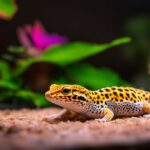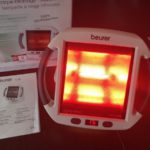Last Updated on 5 months by Francis
Bearded dragons are beloved reptile pets known for their unique appearance and docile nature. As responsible pet owners, it is crucial to provide them with the appropriate care, including proper heating and lighting. Infrared lights have become a popular choice for providing warmth and light to bearded dragons, but there are concerns about their potential negative effects.
While infrared lights can offer benefits such as maintaining body temperature, aiding digestion, and regulating sleep patterns for bearded dragons, there are potential risks if not used correctly. Prolonged exposure to infrared light can lead to eye damage and disrupt natural sleeping patterns for these reptiles.
Contents
Key Takeaways:
- Proper heating and lighting are essential for the well-being of bearded dragons.
- Infrared lights can be beneficial for bearded dragons but should be used with caution.
- Prolonged exposure to infrared light can cause eye damage and disrupt sleep patterns.
- Using a reliable brand of infrared light and placing it at the correct distance from the basking spot is crucial.
- Consulting with a reptile expert or veterinarian can provide personalized advice on bearded dragon care.
Can I Use Infrared Light For Bearded Dragon?
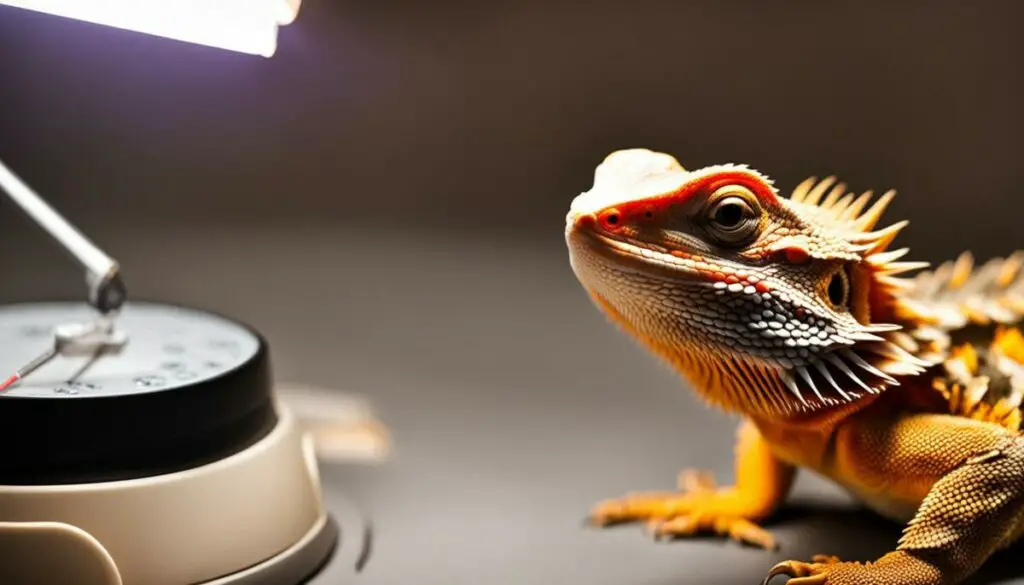
Many bearded dragon owners wonder whether it is safe to use infrared light for their pets. The good news is that infrared light can indeed be used for bearded dragons and provides several benefits. Infrared light helps maintain the dragon’s body temperature, aids in digestion, and regulates their sleep patterns. It is an essential component of their overall well-being.
However, it is crucial to ensure the safe use of infrared light for bearded dragons. Using a reliable brand of infrared light is important to minimize any potential risks. Additionally, the distance between the light source and the dragon’s basking spot should be carefully observed to prevent any harm. It is also recommended to use a combination of lighting sources to provide the appropriate amount of light and heat for your bearded dragon.
By following these guidelines and maintaining proper levels of infrared light, you can provide a comfortable and healthy environment for your bearded dragon. Always prioritize their well-being and consult with a reptile expert or veterinarian for personalized advice on their care.
The Benefits of Infrared Light for Bearded Dragons:
- Helps maintain body temperature
- Aids in digestion
- Regulates sleep patterns
Using infrared light for bearded dragons is safe and beneficial. However, it is essential to use a reliable brand and ensure proper placement to avoid any potential risks. With the right care and attention, you can provide a comfortable and thriving environment for your beloved bearded dragon.
Can Bearded Dragons Use Red Heat Lamps?
When it comes to heating and lighting options for bearded dragons, red heat lamps are not recommended. While they may be commonly used, there are potential risks and harm associated with their use. Red heat lamps are too bright and can damage the dragon’s vision. Additionally, they can disrupt the dragon’s sleep patterns, leading to stress, appetite loss, and a compromised immune system.
So, what are the alternatives to red heat lamps for bearded dragons? Ceramic heat emitters or basking lights are better options for providing the necessary warmth and lighting. These alternatives offer the right balance of heat without the harmful effects of red light. It is crucial to keep the lamp away from any potential fire hazards, as heat lamps can become dangerously hot.
To ensure the safety and well-being of your bearded dragon, it is essential to consider proper heating and lighting practices. This includes using reliable heating sources that do not emit harmful red light. By choosing the right alternative, you can create a comfortable and healthy environment for your beloved pet.
| Red Heat Lamps | Alternative Heating Options |
|---|---|
| Too bright and damaging to the dragon’s vision | Ceramic heat emitters or basking lights |
| Disrupt sleep patterns and cause stress | Provide necessary warmth without harmful effects |
| Increase the risk of fire hazards | Safe and reliable heating sources |
What Can I Use Instead Of A Heat Lamp For Bearded Dragons?

While heat lamps are a common choice for providing warmth to bearded dragons, there are alternative heating options available that can fulfill their needs. Here are some alternatives to consider:
- Ceramic Heaters: Ceramic heaters are a popular choice for nighttime heating. They emit infrared heat without producing light, offering a natural and cozy environment for the dragon to sleep. Ceramic heaters are safe to use and can be controlled with a micro-climate thermostat to maintain the desired temperature.
- Heat Mats: Heat mats are another alternative that can be used to provide gentle heat from below. They are placed underneath the tank or enclosure and offer localized warmth for the dragon. Heat mats can be particularly useful for providing belly heat, which helps with digestion.
- Blankets: In addition to heating devices, blankets can also play a role in keeping bearded dragons warm. Wrapping the tank with a blanket or towel can help insulate the enclosure, retaining heat and creating a cozy environment for the dragon.
It’s important to monitor the temperature closely when using alternative heating options and make adjustments as necessary to ensure the dragon’s comfort and well-being.
| Heating Option | Description | Pros | Cons |
|---|---|---|---|
| Ceramic Heaters | Emits infrared heat without light | – Provides natural nighttime environment – Controlled with a thermostat |
– Requires additional setup and equipment – May need supervision |
| Heat Mats | Provides gentle heat from below | – Offers localized warmth – Helps with digestion |
– Limited coverage area – May not be suitable for all setups |
| Blankets | Insulates the enclosure | – Creates a cozy environment – Cost-effective solution |
– Requires regular monitoring – May not provide sufficient heat on its own |
Quote:
“Using alternative heating options like ceramic heaters or heat mats can provide a safe and effective alternative to heat lamps for bearded dragons. These options offer a natural and comfortable source of warmth, ensuring the well-being of your pet.”
When considering alternative heating options, it’s essential to prioritize the safety and comfort of your bearded dragon. Ensure that the chosen method provides the necessary heat without posing any risks or discomfort to your pet. Consulting with a reptile expert or veterinarian can help you make an informed decision based on your specific setup and the needs of your bearded dragon.
Alternative Heating Options for Reptiles and Bearded Dragons
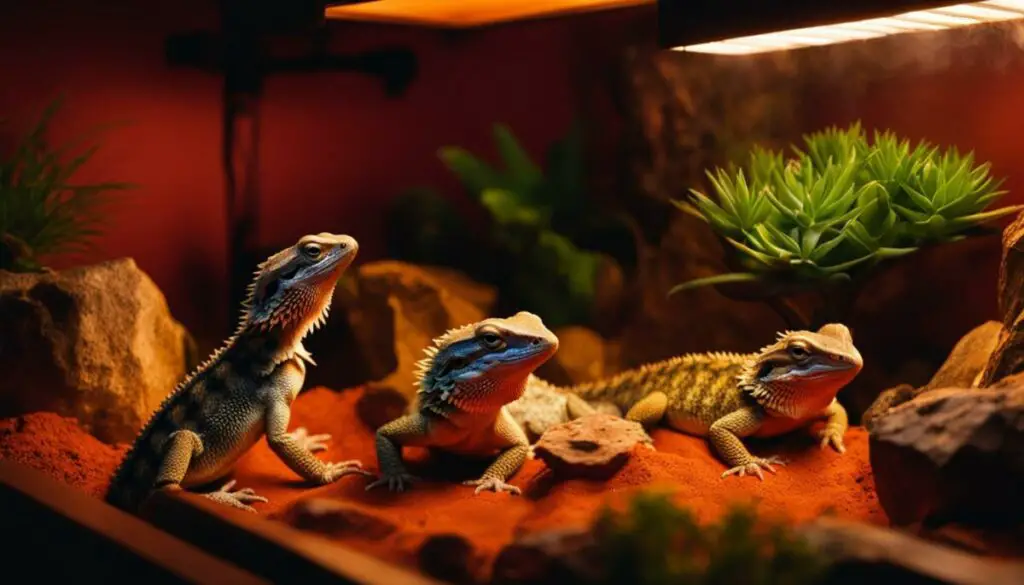
When it comes to heating options for reptiles, including bearded dragons, there are several alternatives to consider. These options provide optimal heating while ensuring the well-being and comfort of your pet. Let’s explore some of the top choices:
Ceramic Heaters
Ceramic heaters are a popular alternative for reptile heating. They emit infrared heat without emitting light, making them ideal for maintaining a constant temperature in the enclosure. Ceramic heaters can be controlled with a micro-climate thermostat, allowing you to set the desired temperature range for your bearded dragon.
Mercury Vapor Bulbs
Mercury vapor bulbs are another excellent option for providing both heat and UVB rays to bearded dragons. These bulbs are a two-in-one solution, offering the necessary lighting and heating in a single source. They are highly efficient and can be used as the primary heat source in your pet’s enclosure.
Heat Pads and Heat Strips
Heat pads and heat strips are alternative heating options that can be used to create warm areas in your reptile’s habitat. These pads and strips are placed underneath the enclosure, providing a gentle heat source from below. They are an excellent choice for reptiles that require a specific temperature gradient within their enclosure.
| Alternative Heating Options | Pros | Cons |
|---|---|---|
| Ceramic Heaters | – Emit infrared heat without light – Can be controlled with a thermostat – Provide a constant temperature |
– Requires a separate light source |
| Mercury Vapor Bulbs | – Provide both heat and UVB rays – Efficient and long-lasting – Suitable as the primary heat source |
– May be more expensive than other options |
| Heat Pads and Heat Strips | – Create warm areas within the enclosure – Ideal for temperature gradients – Can be used with other heating sources |
– Require proper installation and monitoring – May not provide sufficient heat on their own |
These alternative heating options offer a safe and effective way to provide the optimal temperature for your bearded dragon. Depending on your pet’s specific needs and the setup of its enclosure, you can choose the option that best suits your requirements. It is essential to monitor the temperature regularly and ensure that your bearded dragon is comfortable and thriving in its habitat.
Do Bearded Dragons Need Infrared Light at Night?

Bearded dragons do not need infrared light at night. While they require exposure to ultraviolet (UV) light during the day for healthy growth and activity, infrared light is not necessary for their nighttime sleep. Instead, the goal is to provide a dark sleep environment for the dragon.
Infrared light, however, can be beneficial for providing necessary warmth and comfort for the dragon to sleep. It helps maintain body temperature and aids in regulating sleep patterns. But it’s important to maintain a proper sleep environment by keeping the vivarium or tank dark at night.
Ensuring a comfortable sleep environment for your bearded dragon is essential. While infrared light can play a role in their overall well-being, it should be used during the day to provide essential heat and light. During the night, darkness without infrared light is preferable to promote a healthy sleep routine for your dragon.
Remember, the well-being of your bearded dragon depends on providing appropriate lighting and heating conditions throughout the day and night. Following proper care guidelines and consulting with a reptile expert or veterinarian will help ensure the health and happiness of your bearded dragon.
The Problem With Red Bulbs
Red bulbs are a popular choice for reptile heating, but they come with some drawbacks when it comes to bearded dragons. While they provide warmth, they emit red light that can disrupt the sleep patterns of these reptiles. Unlike humans, bearded dragons can see colors and lights, including red light. This can cause stress, appetite loss, and a compromised immune system. Additionally, red light does not cause the pupils of bearded dragons to contract enough to protect their eyes from harmful UV rays.
Infrared light, which is emitted by red bulbs, can also penetrate the skin of reptiles and potentially burn their tissue. This can cause serious harm to the bearded dragon if exposed to prolonged or close-range infrared light. When it comes to reptile heating, it’s important to prioritize the well-being and safety of the animal, and that means considering alternatives to red bulbs.
“Red bulbs are not recommended for bearded dragons as they can disrupt their sleep patterns and pose potential risks to their health. It’s best to explore other safer options for providing proper heating and lighting for these reptiles.” – Reptile Expert
Considering the drawbacks and risks associated with red bulbs, it is advisable to opt for alternative heating options for bearded dragons. By using ceramic heaters, fluorescent bulbs, or mercury vapor bulbs, you can provide suitable levels of heat without the disruptive effects of red light. These alternatives offer reliable and efficient heating options while prioritizing the overall well-being of your bearded dragon.
| Drawbacks of Red Bulbs | Risks of Using Red Bulbs | Harmful Effects of Red Light | Infrared Light Penetration in Reptiles |
|---|---|---|---|
| Disrupt sleep patterns | Stress, appetite loss, compromised immune system | Does not protect eyes from harmful UV rays | Potential tissue burns |
| Can cause stress and discomfort | Interferes with natural sleep cycles | Increased risk of eye damage | Higher risk of tissue damage |
| Not suitable for reptiles’ vision | Disruptive to overall health and well-being |
Alternatives to Red Bulbs
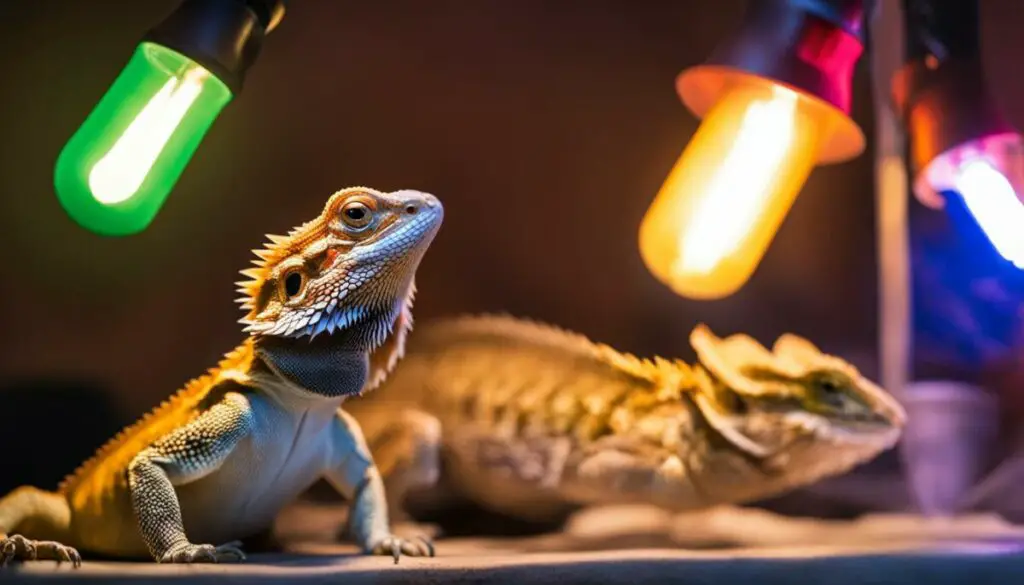
When it comes to providing the right heating and lighting for your bearded dragon, there are alternatives to red bulbs that can be safer and more effective. Here are some options to consider:
Ceramic Heaters for Night Time Heating
A ceramic heater is a great alternative to red bulbs for providing heat during the night. These heaters emit infrared heat without emitting light, creating a dark and comfortable sleep environment for your bearded dragon. They can be controlled with a micro-climate thermostat to maintain the desired temperature.
Fluorescent Bulbs for Reptile Lighting
Fluorescent bulbs provide a source of UVB rays for your bearded dragon, which is essential for their overall health. Some options also provide UVA rays, which can help stimulate natural behaviors. These bulbs are a good alternative to red bulbs as they provide the necessary lighting without disrupting sleep patterns.
Mercury Vapor Bulbs for Bearded Dragons
Mercury vapor bulbs are a two-in-one option as they provide both heat and UVB rays. These bulbs are a popular choice among reptile owners for their efficiency and convenience. They can be used as a primary heat and lighting source for your bearded dragon, ensuring they receive the necessary warmth and UVB exposure.
When choosing an alternative to red bulbs, it is important to ensure proper shade is used to lower the intensity of UV rays and protect your bearded dragon. Additionally, always maintain a safe distance between the bulb and your dragon’s enclosure to prevent any potential harm.
| Alternative | Advantages | Disadvantages |
|---|---|---|
| Ceramic Heaters | Provide infrared heat without light, controlled with a thermostat | May require additional lighting sources for UVB exposure |
| Fluorescent Bulbs | Provide UVB rays, some options provide UVA as well | May not provide sufficient heat, additional heating source may be needed |
| Mercury Vapor Bulbs | Provide both heat and UVB rays, convenient two-in-one option | May be more expensive than other alternatives |
By considering these alternatives to red bulbs, you can provide your bearded dragon with the necessary heating and lighting without the potential risks associated with red light. Remember to always prioritize the well-being and safety of your pet when making choices about their environment.
Some Things to Keep In Mind
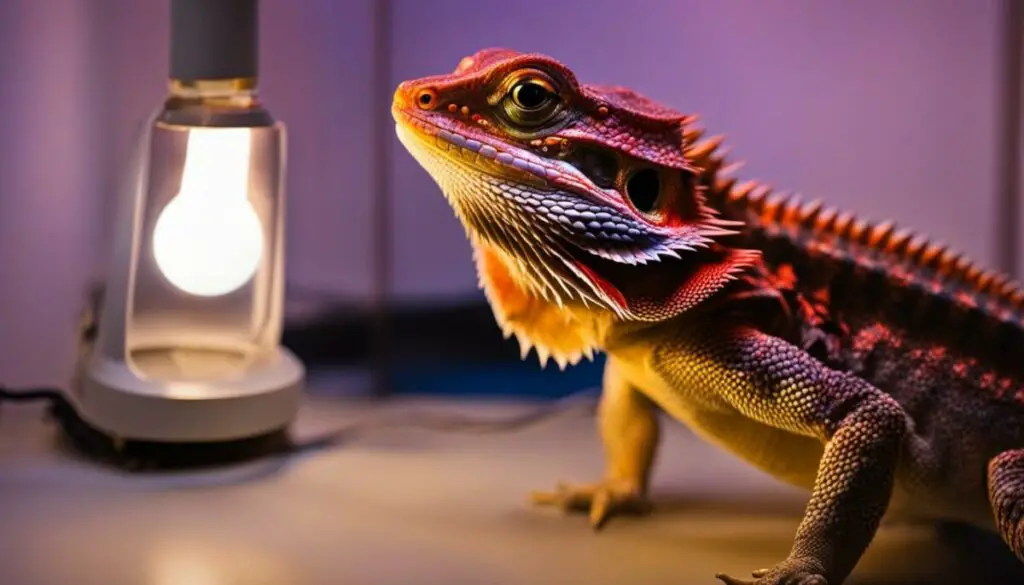
When considering alternative heating options for your bearded dragon, there are several important factors to keep in mind to ensure their safety and well-being. Here are some key considerations:
Proper Positioning of Heating Bulbs
It is crucial to position the heating bulbs correctly to provide optimal heat distribution. The bulbs should be placed at the appropriate distance from the basking spot to maintain the desired temperature. Additionally, ensure that there are no obstacles blocking the heat and UV rays from reaching your bearded dragon. By following proper positioning guidelines, you can create a warm and comfortable environment for your pet.
Safety Precautions for Reptile Heating
When using alternative heating options, it is important to take safety precautions to prevent any potential accidents or harm to your bearded dragon. Ensure that the fixtures you use can handle the wattage of the heating source and are securely installed. Avoid placing any meltable materials near the heat source to reduce the risk of fire or other accidents. By prioritizing safety, you can provide a secure and hazard-free heating solution for your bearded dragon.
Avoiding Meltable Materials Near Heat Source
Be cautious of any meltable materials in the vicinity of the heating source. Heat lamps and other heating devices can reach high temperatures, posing a risk if they come into contact with materials that can easily melt or catch fire. Keep the area surrounding the heat source clear of any potentially hazardous materials to ensure the safety of your bearded dragon and prevent any unwanted incidents.
| Considerations | Solutions |
|---|---|
| Proper positioning of heating bulbs | Place bulbs at the correct distance from the basking spot |
| Safety precautions for reptile heating | Ensure fixtures can handle wattage and are securely installed |
| Avoiding meltable materials near heat source | Keep the area clear of materials that can melt or catch fire |
Do Bearded Dragons Need Infrared Lights at Night?
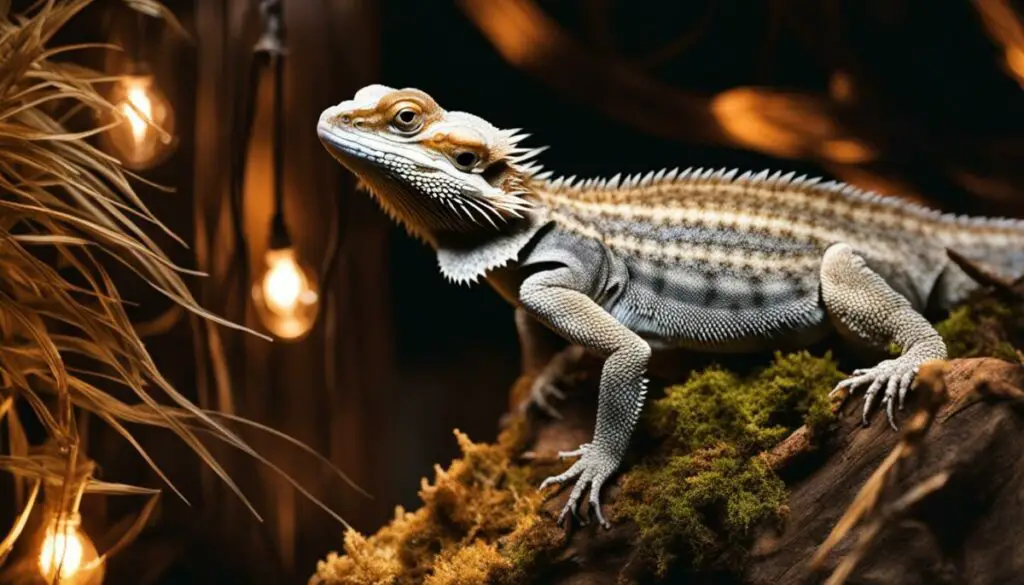
Providing the right lighting and temperature for your bearded dragon is crucial for their health and well-being. While infrared lights can be beneficial during the day for maintaining body temperature and aiding in digestion, they are not necessary at night. In fact, it is important to provide a dark sleep environment for your dragon during the nighttime hours.
Bearded dragons, like other reptiles, require a period of darkness to regulate their sleep patterns. This is essential for their overall health and allows them to rest and recharge. Keeping the vivarium or tank dark at night helps create a natural and comfortable sleep environment for your dragon.
However, it is important to maintain proper temperature regulation for your bearded dragon at night. The temperature should not drop below 18°C to ensure their well-being. Using a thermostat can help you control the heat and provide a comfortable sleep environment for your dragon without the need for infrared lights.
Providing Darkness for Bearded Dragons at Night: Key Points
- Bearded dragons do not require infrared lights at night.
- A dark sleep environment is important for regulating their sleep patterns.
- Maintain a temperature above 18°C during the night to ensure their well-being.
- Use a thermostat to control the heat and provide a comfortable sleep environment.
Summary
While infrared lights can be beneficial for bearded dragons during the day, they are not necessary at night. Creating a dark sleep environment is essential for regulating their sleep patterns. Bearded dragons require a temperature above 18°C during the night to ensure their well-being, and using a thermostat can help you maintain a comfortable sleep environment without the need for infrared lights.
Can you leave a heat lamp turned on all night for a bearded dragon?
Leaving a heat lamp on all night for a bearded dragon is not necessary. Bearded dragons do not require the same temperature at night as they do during the day. In fact, they prefer a slightly lower temperature to mimic their natural environment. Continuous heat throughout the night can potentially lead to overheating and discomfort for the dragon. It is recommended to provide a safe sleep environment for the bearded dragon by using a thermostat to regulate the heat and ensure the temperature does not drop below 18°C.
Monitoring the temperature is crucial to prevent any risks associated with overheating. By using a thermostat, you can accurately control the temperature and provide a comfortable sleep environment for your bearded dragon. Avoiding continuous heat at night allows the dragon to experience natural temperature fluctuations and promotes better sleep patterns.
It is important to create a balance between maintaining the appropriate temperature for the dragon and allowing it to experience a natural day and night cycle. By following these guidelines and providing a safe sleep environment, you can ensure the well-being and comfort of your bearded dragon.
Summary:
- Bearded dragons do not need continuous heat throughout the night.
- They prefer a slightly lower temperature to mimic their natural environment.
- Using a thermostat can help regulate the temperature and prevent overheating.
- Providing a safe sleep environment promotes natural sleep patterns for the dragon.
Table: Summary of Nighttime Heating for Bearded Dragons
| Heating method | Benefits | Cautions |
|---|---|---|
| Using a thermostat | Allows accurate control of temperature | Monitor temperature to prevent overheating |
| Avoiding continuous heat | Promotes natural sleep patterns | Ensure the temperature does not drop below 18°C |
Conclusion
After considering the use of infrared lights for bearded dragons, it is clear that they can be beneficial when used correctly. Infrared light helps regulate body temperature, aids digestion, and promotes healthy sleep patterns. However, it is important to be aware of the potential risks associated with prolonged exposure to infrared light, such as eye damage and disrupted sleep. To ensure the well-being of your bearded dragon, it is recommended to use reliable brands of infrared lights and place them at the correct distance from the dragon’s basking spot.
Alternatively, there are several safe and effective alternative heating options for bearded dragons. Ceramic heaters provide infrared heat without emitting light and can be controlled with a micro-climate thermostat. Fluorescent bulbs offer UVB rays, and mercury vapor bulbs provide both heat and UVB rays. Proper positioning, safety precautions, and temperature regulation are essential when using any heating method.
In conclusion, it is important to prioritize the health and comfort of your bearded dragon by following safe heating and lighting practices. Consultation with a reptile expert or veterinarian can provide personalized advice based on the specific needs of your bearded dragon. By considering the information presented in this article, you can ensure a happy and thriving pet.
FAQ
Are infrared lights bad for bearded dragons?
Infrared lights can be beneficial for bearded dragons when used appropriately, but there are potential risks if not used correctly. Prolonged exposure to infrared light can cause eye damage and disrupt sleep patterns.
Can I use infrared light for bearded dragons?
Yes, infrared light can be used for bearded dragons. It helps maintain body temperature, aids in digestion, and regulates sleep patterns. It is important to use a reliable brand of infrared light and place it at the correct distance from the basking spot.
Can bearded dragons use red heat lamps?
Red heat lamps are not recommended for bearded dragons. They are too bright and can be damaging to the dragon’s vision. Ceramic heat emitters or basking lights are better options for providing the necessary warmth and lighting.
What can I use instead of a heat lamp for bearded dragons?
Ceramic heaters, heat mats, and hot water bottles can be used as alternative heating options for bearded dragons. Blankets and body heat can also provide additional warmth and comfort for the dragon.
What are the alternative heating options for reptiles and bearded dragons?
Alternative heating options for reptiles and bearded dragons include ceramic heaters, heat pads, heat strips, and mercury vapor bulbs. Proper shade and distance from the bulb should be maintained to prevent any harm to the dragon.
Do bearded dragons need infrared light at night?
Bearded dragons do not need infrared light at night. They require exposure to ultraviolet light during the day for healthy growth and activity. Infrared light can provide necessary warmth and comfort for the dragon to sleep, so it is important to maintain a proper sleep environment by keeping the vivarium/tank dark at night.
What is the problem with red bulbs?
Red bulbs are commonly used for reptile heating, but they have drawbacks. Reptiles can see colors and lights, including red light, which can disrupt their sleep. Infrared light can penetrate the skin and potentially burn the dragon’s tissue. It is best to use alternative heating options that do not emit red light.
What are the alternatives to red bulbs?
Alternatives to red bulbs for bearded dragons include ceramic heaters, fluorescent bulbs, and mercury vapor bulbs. Ceramic heaters emit infrared heat without emitting light, fluorescent bulbs provide UVB rays, and mercury vapor bulbs provide both heat and UVB rays.
What are some things to keep in mind when using alternative heating options?
When using alternative heating options, it is important to ensure proper positioning of heating bulbs to ensure proper heat distribution. Nothing should be blocking or absorbing the heat and UV rays from reaching the dragon. It is also important to use fixtures that can handle the heat wattage and keep meltable materials away from the heat source to avoid accidents.
Do bearded dragons need infrared lights at night?
Bearded dragons do not need infrared lights at night. The goal is to provide a dark sleep environment for the dragon. Proper temperature regulation is important, with temperatures not dropping below 18°C. It is recommended to use a thermostat to control the heat and ensure a comfortable sleep environment for the dragon.
Can you leave a heat lamp turned on all night for a bearded dragon?
Heat lamps can be left on all night, but it is not necessary for bearded dragons. They do not need the same temperature at night and prefer a slightly lower temperature. Using a thermostat to regulate the heat can help prevent overheating and ensure a safe sleep environment for the dragon.
Conclusion
Infrared lights can be beneficial for bearded dragons when used appropriately. Prolonged exposure to infrared light can have potential risks, so it is important to consider alternative heating options, such as ceramic heaters and mercury vapor bulbs. Proper positioning, safety precautions, and temperature regulation are important for the well-being of bearded dragons. It is recommended to consult with a reptile expert or veterinarian for personalized advice on proper heating and lighting for bearded dragons.




